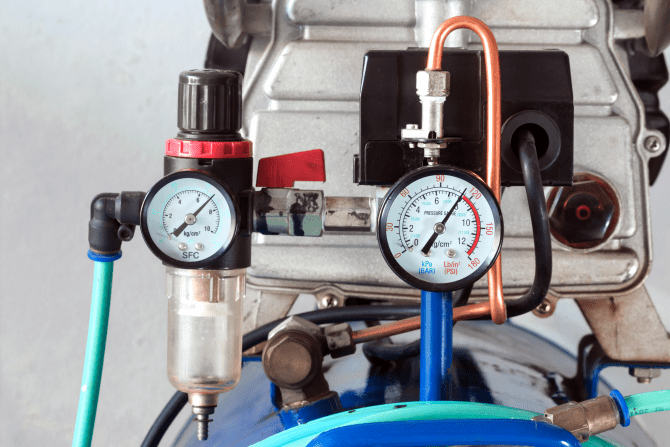Pressure Regulation Methods for Compressed Air Systems
Were you aware that pressure is one of the main factors that determine a compressed air system’s capacity and power? This means that it is essential to understand the pressure requirements of your facility, process, and/or application, and to design your compressed air system accordingly. If the compressor system is instead designed for a much higher or lower pressure than required, it can lead to increased operating costs – or further investments if you must adapt and modify the system for lower pressure.

Benefits of Pressure Regulation
To avoid unnecessary costs and compromising other compressed air system components, you should think about enacting some form of pressure regulation. This is a way to ensure that your machine delivers the required operating pressure value without the issues mentioned above. The best-designed systems will build adequate pressure as required by the process, maintaining the pressure without much fluctuation. Other benefits that can be realized by adding appropriate controls to your compressor system include:
Reducing energy consumption and costs. This will help in improving pressure control and operating efficiencies when you have multiple compressors.
Protecting your process and end products from high-pressure air that may damage downstream instruments, devices, valves, and other pneumatic equipment.
Delivering the required value of the pressure to the application and avoiding any malfunction, downtime, or fault in the application due to low-pressure air delivery.
Pressure Regulations Systems
Start/Stop
The start/stop control is one of the simplest control schemes available. The controller sends a signal to the compressor’s main motor, letting it know when to start or stop based on preset pressure points. Start/stop controls are the most basic and used for compressors with low duty cycles at 25 hp or lower.
Load/Unload
The load/unload control is also known as the constant speed control because the motor is constantly running. Load/unload is also the most common pressure regulation method. Instead of turning off the motor when the demand for air is reached, the motor will still run, but the inlet valve will close, which recirculates air inside the compressor and prevents compressed air from blowing out of the inlet. The compressor’s controller stops the unit whenever possible to reduce the power consumption and restarts it automatically when the net pressure decreases. If the expected unloading period is too short, the unit is kept running to prevent too short standstill periods.
Modulation
In a modulating inlet control, the output of a compressor is varied to meet flow requirements typically by using an inlet valve. First, a regulating valve senses the discharge pressure and sends proportional pressure to operate the inlet valve. As pressure rises in the compressor, the inlet valve starts closing, or throttling, which restricts inlet air and decreases pressure. This situation ultimately creates a vacuum on the compressor’s inlet side while its outlet pressure remains fairly constant.
Variable Displacement
With variable displacement, the compressor’s output capacity is varied using capacity control valves, also known as spiral, turn, or poppet valves. This control scheme manages output pressure and the compressor’s power consumption by changing the length of the compression chamber.
Variable Speed Drive
Variable Speed Drive (VSD) is a continuous flow regulation that uses a special drive to control the speed of the motor while maintaining a constant delivery pressure. It uses its inverter for a soft start while the motor ramps up to speed. By varying the electric motor’s frequency or voltage, the motor can be controlled by the demand for air. The fluctuations in pressure are eliminated, as pressure is maintained by regulating the speed of the motor through the compressor controller – all based on anticipation of the system pressure increase or decrease. VSD regulation can bring substantial savings by removing the unloaded operation of the compressor.
Compressor service contract and parts for “EVERY COMPRESSOR, EVERY BRAND” in Pakistan.
📞 +92 333 0135392; +92 334 5933391
📧 info@sakoon.com.pk



Leave a Reply
Want to join the discussion?Feel free to contribute!